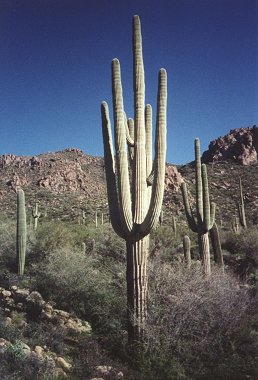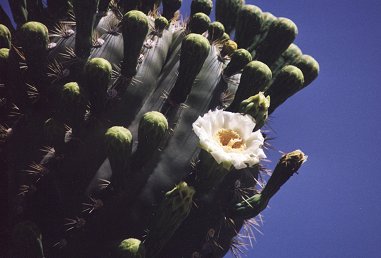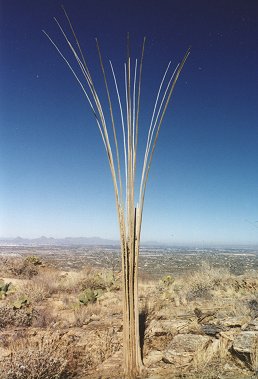The Saguaro is the largest cactus in the
United States and the most famous of the Sonoran
 Desert
flora. Saguaros typically grow to heights of 40 ft, though one cactus
was measured at 78 ft. The saguaro has a cylindrical stem with pleated
ribs which are lined with clusters of stiff spines (supposedly the
spines that grow above 8 ft are more flexible). Saguaros are most
profuse in southern Arizona, though some may also be found in western
Sonora and along the Southern California border. They typically grow on rocky
slopes and in well drained flat lands below 4000' in elevation. Desert
flora. Saguaros typically grow to heights of 40 ft, though one cactus
was measured at 78 ft. The saguaro has a cylindrical stem with pleated
ribs which are lined with clusters of stiff spines (supposedly the
spines that grow above 8 ft are more flexible). Saguaros are most
profuse in southern Arizona, though some may also be found in western
Sonora and along the Southern California border. They typically grow on rocky
slopes and in well drained flat lands below 4000' in elevation.
|
Saguaros are more numerous on
south facing slopes. These slopes receive more direct sunlight and
are therefore warmer and better suited to saguaro survival. |
The saguaro has a thick waxy skin that restricts loss of moisture. The
outer surface is covered with pleats, which allow the stem to expand
during water uptake, preventing the cactus from bursting. A mature
saguaro can soak up 200 gallons of water during a single rain storm.
Areoles (the pads which produce spines) are spaced at 1" intervals
along the pleats. The spines serve to protect the cactus from
herbivores and provide some protection from the sun. Just beneath the
skin is a thin layer of chlorophyll containing cells in which
photosynthesis takes place. Beneath that layer, and making up the bulk
of the cactus, is water storage tissue. A saguaro is typically more
than 90% water. Water is needed for plant survival, but also plays an
important role in heat regulation. The water within the cactus heats
slowly throughout the day (preventing the cactus from cooking), then
releases its heat at night, keeping the cactus warm. At the center of
the saguaro is a woody skeletal structure which runs the length of the
main stem and branches into the arms. The saguaro has a main root stem
that extends downward about 2 feet. The remainder of the root system
is very shallow (usually no more than 4 inches below the surface) and
extends radially away from the plant to a distance about as far as the
plant is tall. Saguaros produce
flowers in May or June once they have achieved a height of about 8 feet. The 3"
white blossoms form on the ends of the stem and arms.
They open at night and remain open part of the following day. It is
commonly accepted that the flowers are pollinated by bats, however,
recent studies suggest that bees and doves play a larger roll in
pollination than bats do. In June and July the flowers mature into 3"
long fruits which contain up to 2000 tiny seeds. The fruits are eaten by
many birds, mammals, and insects. Seed dispersal is primarily performed
by birds, which are unable to digest the seeds. If a saguaro seed finds
itself in a favorable place to grow it may form a seedling. Seedlings
grow very slowly during the first few years and are susceptible to
herbivores and the elements. Successful seedlings usually can be found
growing underneath a nurse plant, such as a palo verde or creosote
bush,
which provides shade and protection for the young plant. Even with
this protection, seedlings require several consecutive years of milder
and wetter than average weather to survive. Because these conditions may occur
only a few times a century it is not uncommon to find large groves of
saguaros that are very close in size and age.
 The speed with which a
saguaro grows depends on the amount of rainfall, the size of the plant
and the type of soil. A typical saguaro may take 10 years to reach
1 1/2 inches in height and 30 years to reach 2 feet. They grow somewhat
quicker after that and grow to a height of 8 feet in about 55 years. The speed with which a
saguaro grows depends on the amount of rainfall, the size of the plant
and the type of soil. A typical saguaro may take 10 years to reach
1 1/2 inches in height and 30 years to reach 2 feet. They grow somewhat
quicker after that and grow to a height of 8 feet in about 55 years.
|
The state flower of Arizona is
the saguaro blossom. |
The plant begins to grow arms when it
is between 50 and 100 years in age. The number and size of the arms is
correlated with soil and rainfall. Some saguaros have been observed
with up to 50 arms, some never grow any. Arms always grow upwards,
those that droop towards the ground are probably the result of frost
damage.
Numerous animals rely on saguaros for
food and shelter. Birds such as the Gila Woodpecker and Gilded Flicker
excavate nest holes in the stems. The saguaro protects itself from
disease by sealing the hole with scar tissue, which becomes dry and
woody. These holes make excellent nesting sites and seem to cause the
plant little damage. Old nests sites may later become residences for
Elf Owls, Finches, Flycatchers or Martins. Larger birds such as Hawks
build nests in the angles between the stem and arms. Saguaros can live
for 150 to 200 years in age, however, even a fallen saguaro can become
a
 home
for many small animals such as snakes, rodents or invertebrates. home
for many small animals such as snakes, rodents or invertebrates.
Native Americans have found many uses
for the saguaro as well. The woody ribs are used for fences and
combined with mud and grasses to make homes. Saguaro fruit is an
important seasonal food and is also used to make a ceremonial wine.
Seeds are also eaten and are consumed plain or dried and ground to
make a flour. |

